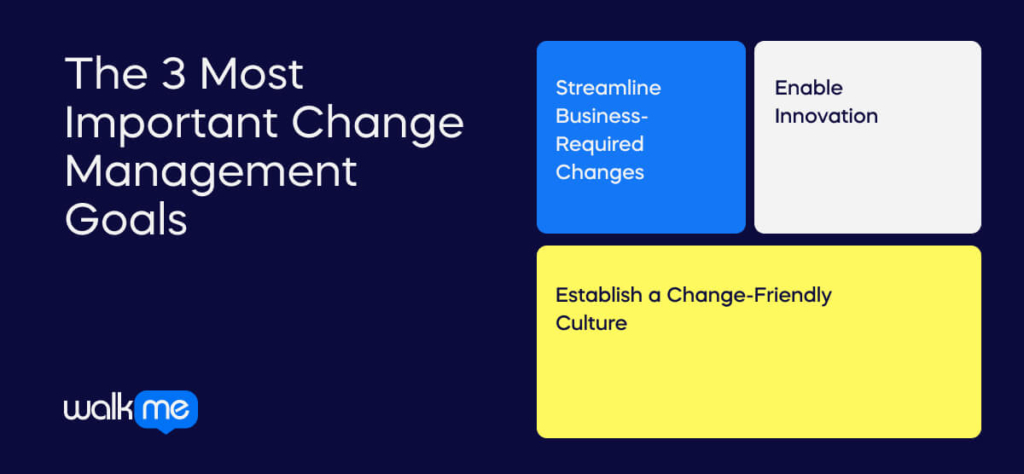If anything is constant in business, it’s change and taxes.
Yes, change management is a necessity. But that doesn’t mean change management can’t also be a powerful tool for driving business growth.
You already know what change management is and why it’s critical to the success of any business. But if you want to get maximum value out of your change management process, setting change management goals to guide and structure your journey can be helpful.

Setting change management goals can also bolster your existing change management processes. Only 34% of change initiatives succeed, and if you want to bump that number up within your organization, then you need to create a series of smaller change management goals that will help you drive up your overall success rate.
But what goals should you set? And how should you measure your progress? What happens if you fail to reach your goals?
Those are the questions we’re looking to answer in this article.
By the time you’re done reading, you’ll know all there is to know about change management goals. What they are, why they matter, and how to measure them.
You’ll learn how to create and implement them in your own business and walk away with an understanding of how to use change management to drive business growth.
What are Change Management Goals, and Why Do They Matter?
Change management goals are objectives set by business leaders to help manage and track the progress of organizational change initiatives.
Change management goals provide structure and guidance and help implement changes successfully.
Setting change management goals is important because it’s difficult to measure success and failure without them.
Goals provide an endpoint that can be used to determine whether or not a change has succeeded in achieving its intended outcome.
They also motivate employees and stakeholders who are involved in the change process. Having clearly defined goals helps them stay focused on their tasks and keep the momentum going throughout the entire process.
Finally, setting change management goals is critical for measuring your ROI (return on investment) and the overall success of your change initiatives.
Without change management goals, knowing if a change was worth the resources you invested is impossible.
The bottom line is this: Setting change management goals helps ensure that you get maximum value out of every change you make.
Whose Job Is It to Set Change Management Goals?
Larger corporations will have a dedicated change leadership team who will own all facets of the change management process. The job usually falls on the organization’s leadership team in smaller businesses.
This could include top executives, such as the CEO or COO, or a department head or senior manager tasked with leading the change process.
Whoever defines your change management goals should know about organizational objectives and understand how each change initiative fits into the larger picture.
They should also be able to identify potential risks and weak points that could derail the change process and any resources or support needed for successful implementation.
Ultimately, it will be the responsibility of whoever sets the change management goals to ensure they are met to achieve organizational success.
It might sound like a lot of knowledge and responsibility to expect from one person. That’s why involving all stakeholders in the change process is important and ensuring everyone is on board with the goals.
This means involving employees at every level of the organization and external stakeholders to get their buy-in and create a unified front.
Top executives often better understand the big picture, whereas technical staff has keen insight into what’s realistically achievable. Ideally, you would factor in the wisdom of every stakeholder when setting change management goals.
By having everyone on board, you can work together to reach your goals faster and with greater success.
How to Set Goals for Change Initiatives

The goals of each change initiative will vary wildly, making setting change management goals seem daunting.
But it’s a critical step if you want to lead more successful change initiatives.
Here are a few practical tips to help you define goals for change initiatives:
Set SMART Goals
SMART stands for Specific, Measurable, Achievable, Relevant, and Time-bound.
When setting change management goals, ensure they are specific enough so everyone involved knows exactly what is expected of them.
Change management goals should also be measurable, so you can track progress over time and measure success at the end of the initiative.
Furthermore, ensure that your goals are achievable with available resources; otherwise, it’s just a pipe dream.
Finally, ensure all the goals are relevant to organizational objectives and have an appropriate timeline.
Keep Goals Clear and Concise
Don’t confuse people by making your change management goals too complex.
Instead, keep them clear and concise so everyone involved knows exactly what’s expected of them.
Lay out the expectations in simple terms that are easy to understand and relate to organizational objectives.
This makes it easier for employees to set goals and develop strategies.
Prioritize Goals in Order of Importance
It’s important to prioritize your change management goals based on their importance and impact on the organization.
For example, you may want to focus first on those goals that have an immediate and measurable effect on performance or customer experience.
That way, you can start seeing results immediately while having plenty of time left over for other initiatives needing longer-term attention.
Break Down Larger Goals
If you have larger goals that need to be achieved, it can be helpful to break them down into smaller, more manageable chunks.
This helps to make the goals more achievable and tangible, as well as setting out a clear path for each step of the change process.
It also makes it easier to assign tasks and responsibilities. This will help you keep track of progress along the way and ensure that each goal is completed on time.
How Change Management Can Drive Business Growth
It’s all good to set goals for each change initiative to increase the odds of success.
But you can take your change management goal-setting a step further.
A common mistake business leaders make is to see change management as a necessary burden— it’s something you must do in reaction to changing business needs.
We don’t see it that way. We think change management can be a tool to actively drive business growth.
But if you want to begin using change management this way, you need to think about your overarching change management goals.
These aren’t the same as the goals you set for individual initiatives. Rather, these are the goals you want your whole change management process to help you achieve.
To illustrate the point, let’s take a look at a few examples:
The 3 Most Important Change Management Goals

Goals change between industries and individual businesses, but we think most companies should aim to achieve the following three goals through effective change management:
Goal: Streamline Business-Required Changes
Organizations must often undertake changes in response to external pressures, such as regulatory demands or customer expectations.
A user-friendly process for managing these changes can help streamline the change process and minimize disruption to your business.
This goal can be broken down into two sub-goals:
Sub-goal: Manage Risks
Change often comes with risk, especially when it comes about as a result of regulatory demands.
One goal of your change management process should be to ensure that changes are made safely and to minimize the risk of mistakes or oversights.
Sub-goal: Minimize Impact
Change can be disruptive to the day-to-day running of your business.
Another goal of your change management process should be to deal with required changes with minimal impact on the business.
Goal: Enable Innovation
Change isn’t just a process for handling necessary changes— it can be a tool for enabling innovation. It can help you achieve your desired business outcomes.
47% of organizations that integrate change management are more likely to meet their objectives than the other 30% that did not incorporate it.
With a structured approach to change management, you can create an environment where people feel comfortable taking risks and developing new ideas.
This can help drive business growth in the long term.
Goal: Establish a Change-Friendly Culture
Finally, your change management goals should include developing a culture that embraces change.
This means creating an environment where employees are encouraged to suggest and test new ideas, even with a degree of risk.
It’s also important to ensure that everyone involved in the business is on board with the idea of embracing change.
This means providing adequate education, training, and resources to help your team understand the importance of change management.
By doing this, you can ensure everyone is on board and comfortable adapting to change. As a result, your business becomes more agile and competitive at its core.
What To Do If You Don’t Achieve Your Change Management Goals
If you don’t achieve your change management goals, the first step is to take a step back and assess what went wrong.
Getting an outside opinion from someone with experience in effective change management processes can be beneficial. Consider partnering with a change management consultant.
A consultant can help you identify areas that need improvement or changes that should have been made differently.
Once you know where things have gone wrong, you can start making adjustments. This could involve tweaking processes, providing additional resources or training, or introducing new digital tools to streamline the change process.
The key is to keep an open mind and be willing to try new approaches and solutions until you find something that works.
Finally, regularly reviewing your change management goals and adjusting them as needed can be helpful. This allows you to stay on top of changes that may be required and ensures that you’re always working towards achieving the desired outcomes for your business.
By doing this, you can ensure that any changes are taking your business in the right direction.
Measuring Change Management
If you’re going to set goals, you need to know how to measure change results. Otherwise, you won’t know whether you’re on track to achieve the change management goals you’ve set.
This means looking at how successful changes are in achieving their intended outcomes.
The metrics for evaluating change management success will depend on your specific goals.
For example, if your goal is to minimize disruption, you may look at how quickly changes are implemented and how smoothly they go.
If your goal is to foster innovation, measuring how successful ideas are in achieving their desired outcomes and how quickly they can be deployed is key.
Measuring the success of your change management processes can help you understand where improvements should be made, identify areas where additional resource allocation may be required, and ensure that changes are implemented effectively to maximize their benefit to the business.
Getting More Out of Change Management by Setting Goals
Setting good change management goals takes a little bit of thinking, but the benefits it offers your business are massive.
With well-thought-out change management goals, you can boost the success rate of change initiatives.
More importantly, you can stop using change management as a process for reacting to necessary changes. Instead, you can use it as a powerful tool for driving business growth.
Setting change management goals provides structure and guidance to an otherwise fuzzy and trepidatious journey.
It’s the key to turning your change management process into a competitive advantage instead of a necessary burden.

